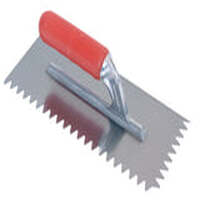A notched trowel is an important tool when tiling. It is used to spread or comb tile adhesive, allowing air to escape when the tile is pressed into it. If you are looking to spread leveling compounds, a straightedge trowel can be used.
Before you begin setting tiles, decide which tile trowel to use. What should be the right size? Should I use a square-notched or U-notched trowel? Those are some common questions you must ask yourself before starting your installation project. Basically, there’s no standard tiling trowel size for tile installation since it depends on the type and size of the tile you install. Each tile type may require a differently sized trowel.
But Why Does Trowel Size Matter?
The notches are important on trowels. They leave a consistent and even amount of mortar down to set your tiles into.
Furthermore, the purpose of the notches is to give the mortar a place to ‘collapse into’ once the tile is installed and compressed down.
To get accurate coverage, you need to choose the right-sized trowel. This will give you that amount of coverage beneath the tile. Check this by placing the tile as you normally would, then pulling the tile up and checking the back.
There should no longer be any trowel line, and you will see complete coverage of adhesive on both the back of the tile and the substrate.

How Are Tiling Trowel Sizes Measured?
The sizing and spacing of the trowel teeth are the basis for measuring tile trowel size. This says how much adhesive the trowel will leave on the substrate when you spread it out. The trowel tooth shape and spacing determine how much adhesive is sandwiched between the tile and substrate once the tile is fully installed.
Using a 12mm*a 12mm square-notched trowel will leave 12mm ridges of adhesive on the substrate with 12mm spaces between each ridge. A tile trowel with only one measurement means that both measurements are the same.
When you choose a 6mm*10mm square-notched trowel, you will leave 6mm wide by 10mm high ridges of adhesive on the substrate, with 6mm spaces between each ridge.
U-notched trowels usually have only one number. This is both the depth and width of the teeth.
Which Trowel Size to Use?
Determining which trowel size is right for your tile placement depends on both the tile and substrate. More accurately, it depends on how flat the tile and substrate are. The lesser flat the tile is, the more adhesive you will need beneath it, which means a larger trowel size.
First, you need to know how much adhesive you need beneath the tile in the finished placement. Also, there are two basic ways to determine the tiling trowel size to use – calculating the warpage of the tile and substrate or visual inspection.
If you are looking for the best size notched trowels with rubber handles, visit Ceramic Tiling Tools. We have tiling trowels available in various different sizes.
Shop today! https://www.ceramic-tiling-tools.co.uk/collections/trowels.
